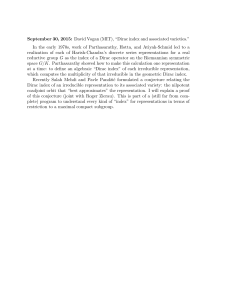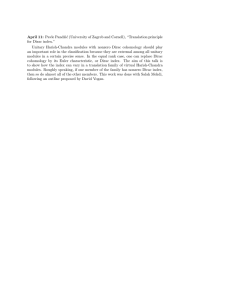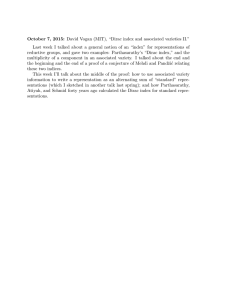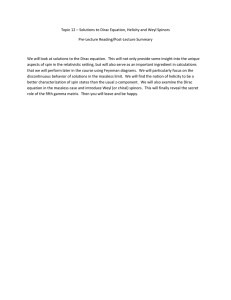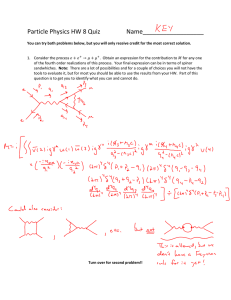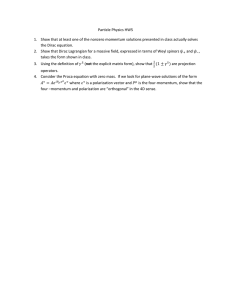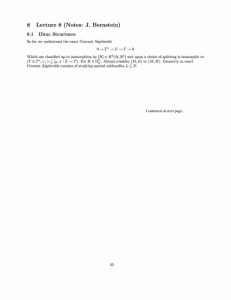18.969 Topics in Geometry, MIT ... Problem sheet 3 ∩U −→ S
advertisement
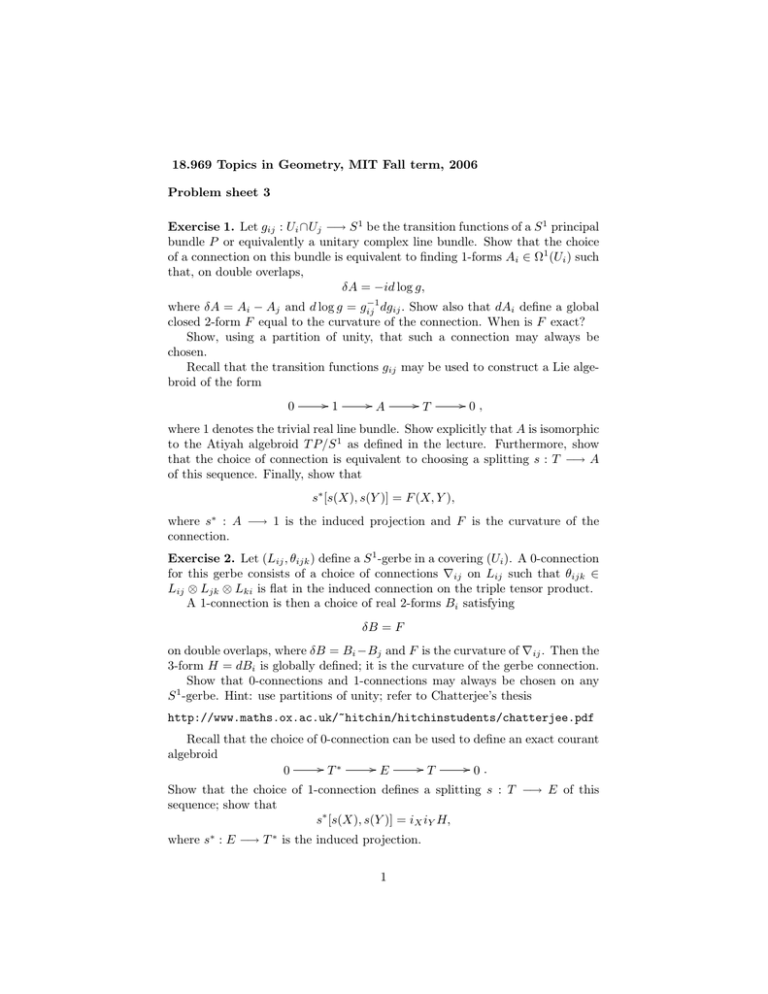
18.969 Topics in Geometry, MIT Fall term, 2006
Problem sheet 3
Exercise 1. Let gij : Ui ∩Uj −→ S 1 be the transition functions of a S 1 principal
bundle P or equivalently a unitary complex line bundle. Show that the choice
of a connection on this bundle is equivalent to finding 1-forms Ai ∈ Ω1 (Ui ) such
that, on double overlaps,
δA = −id log g,
−1
where δA = Ai − Aj and d log g = gij
dgij . Show also that dAi define a global
closed 2-form F equal to the curvature of the connection. When is F exact?
Show, using a partition of unity, that such a connection may always be
chosen.
Recall that the transition functions gij may be used to construct a Lie alge­
broid of the form
0
�1
�A
�T
�0,
where 1 denotes the trivial real line bundle. Show explicitly that A is isomorphic
to the Atiyah algebroid T P/S 1 as defined in the lecture. Furthermore, show
that the choice of connection is equivalent to choosing a splitting s : T −→ A
of this sequence. Finally, show that
s∗ [s(X), s(Y )] = F (X, Y ),
where s∗ : A −→ 1 is the induced projection and F is the curvature of the
connection.
Exercise 2. Let (Lij , θijk ) define a S 1 -gerbe in a covering (Ui ). A 0-connection
for this gerbe consists of a choice of connections �ij on Lij such that θijk ∈
Lij ⊗ Ljk ⊗ Lki is flat in the induced connection on the triple tensor product.
A 1-connection is then a choice of real 2-forms Bi satisfying
δB = F
on double overlaps, where δB = Bi −Bj and F is the curvature of �ij . Then the
3-form H = dBi is globally defined; it is the curvature of the gerbe connection.
Show that 0-connections and 1-connections may always be chosen on any
S 1 -gerbe. Hint: use partitions of unity; refer to Chatterjee’s thesis
http://www.maths.ox.ac.uk/~hitchin/hitchinstudents/chatterjee.pdf
Recall that the choice of 0-connection can be used to define an exact courant
algebroid
� T∗
�E
�T
�0.
0
Show that the choice of 1-connection defines a splitting s : T −→ E of this
sequence; show that
s∗ [s(X), s(Y )] = iX iY H,
where s∗ : E −→ T ∗ is the induced projection.
1
Exercise 3. Let β, β � be gauge equivalent Poisson structures, i.e.
β � = β(1 + Bβ)−1
for B ∈ Ω2cl (M ) and such that the inverse above exists. Verify that β � is indeed
Poisson, and show that there is a canonical isomorphism between the β and β �
Poisson cohomology groups.
Exercise 4. Let ρ ∈ Ω• (G) be a left-invariant form on a Lie group G. Show
that dρ = 0 if ρ is also right-invariant.
Exercise 5. Let θL ∈ Ω1 (G, g) be the left Maurer-Cartan form. Show that
dθL + 12 [θL , θL ] = 0,
where [θ, θ] ∈ Ω2 (M, g) is defined by [θ, θ](v, w) = [θ(v), θ(w)] for any θ ∈
Ω1 (M, g) and v, w vector fields. Hint: See Helgason “Differential geometry, Lie
groups, and symmetric spaces”, p. 138.
Exercise 6. Show that j ∗ θR = −θL . Conclude from the above that dθR −
1 R R
2 [θ , θ ] = 0. Verify this explicitly for the case G = GLn .
Exercise 7. Show that
θR (aL )|g = Adg (a)
for a ∈ g.
Exercise 8. Let B be a bi-invariant metric on the Lie group G. Show that
B(θL , [θL , θL ])(aL , bL , cL ) = 6B(aL , [bL , cL ]) = −6B(aR , [bR , cR ]).
Exercise 9. Let LC = Span{aL − aR + B(aL + aR ) : a ∈ g} be the canonical
Dirac structure on (G, B).
• We saw that it is a twisted Poisson structure Γβ in the open set U ⊂ G
where Adg + 1 ∈ End(g) is invertible. Determine explicitly the bivector β
in U .
• For G = SU (2) = S 3 , describe the conjugacy classes and the loci where
Adg + 1 is invertible, has rank 2, 1, and 0.
** Determine the Lie algebroid cohomology H • (LC ). (Hint: the map g −→
LC given by a �→ aL − aR + B(aL + aR ) is bracket-preserving).
Exercise 10. Let L ⊂ V ⊕ V ∗ be a linear Dirac structure, so that it is deter­
mined by C = L ∩ V and γ ∈ ∧2 (V /C). If f : V −→ W is a linear map, show
that the induced forward Dirac map can be expressed as follows:
f∗ L(C, γ) = L(f∗ C, f∗ γ).
In particular, conclude that the forward Dirac map induced by a composition
of linear maps f : V −→ W , g : W −→ X satisfies (g ◦ f )∗ = g∗ ◦ f∗ .
2
State and prove the analogous results for backward Dirac maps.
For an alternative proof of this fact using Weinstein’s symplectic category,
see “Gauge equivalence of Dirac structures and symplectic groupoids,” Bursztyn
and Radko, math.SG/0202099.
Exercise 11. Let L ⊂ T ⊕ T ∗ be an H-twisted Dirac structure on N and
let M ⊂ N be a leaf of the generalized distribution Δ = πT (L) on N . Then
L = L(Δ, �) where � ∈ Ω2 (M ). Show using the integrability of L that d� = f ∗ H,
where f : M −→ N is the inclusion map. Hence conclude that (M, �) is a Dirac
brane for (N, H, L).
3

